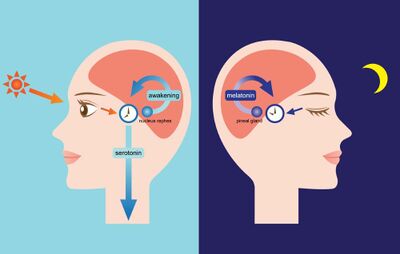How E. aerogenes Affects Circadian Rhythm
Circadian Rhythm

By Olivia Smith
At right is a sample image insertion. It works for any image uploaded anywhere to MicrobeWiki.
The insertion code consists of:
Double brackets: [[
Filename: PHIL_1181_lores.jpg
Thumbnail status: |thumb|
Pixel size: |300px|
Placement on page: |right|
Legend/credit: Electron micrograph of the Ebola Zaire virus. This was the first photo ever taken of the virus, on 10/13/1976. By Dr. F.A. Murphy, now at U.C. Davis, then at the CDC. Every image requires a link to the source.
Closed double brackets: ]]
Other examples:
Bold
Italic
Subscript: H2O
Superscript: Fe3+
Circadian rhythm is a natural endogenous process that regulates the sleep-wake cycle in an organism [2]. This clock cycle is driven by an internal diurnal oscillator set for a period of 24 hours [1]. Circadian rhythms regulate behavior, organs, specifically the gut, and cells in living organisms [4]. External environmental cues, including light, temperature, and redox cycles, can adjust the cycle [2]. Organisms evolved to develop regulatory clock cycles to adapt to the circadian nature of their environment [1]. To competitively survive, as well as optimize function and health, organisms have accommodated rhythmic environmental challenges [2]. Animals, bacteria, fungi, and plants all exhibit diurnal oscillations of varying degrees of complexity [1]. This page explains the bidirectional relationship between daily fluctuations of gut microbiota and its host.
The circadian rhythm is linked to the light/dark cycle [3]. The suprachiasmatic nucleus drives the light/dark cycle in the hypothalamus [1]. In mammals, the primary circadian clock is located in the suprachiasmatic nucleus in the hypothalamus [1]. The suprachiasmatic nucleus generates the clock cycle and synchronizes the periphery [1]. The cycle is synchronized to solar time by retinal afferents from intrinsically photoreceptive retinal ganglion cells [1]. The eye’s retina contains photoreceptive ganglion cells that are photoreceptive and project to the suprachiasmatic nucleus [1].
Ganglion cells contain melanopsin, a photopigment, and signals down a pathway to the suprachiasmatic nucleus [9]. The information from the retinal ganglion cells interprets the lengths of the day and night and passes it to the pineal gland in the epithalamus [9]. The pineal secretes the hormone melatonin. Melatonin secretion peaks at night and ebbs during the day [9]. Pineal melatonin feeds back to suprachiasmatic nucleus rhythmicity to modulate circadian cycles [9].
There are proteins in the suprachiasmatic nucleus that activate the transcription of genes encoding the repressors PERIOD and CRYPTOCHROME [1]. The products of these genes can form a repressive complex [1]. This PER/CRY complex can translocate into the nucleus and inhibit the suprachiasmatic nucleus proteins CLOCK and BMAL1 from transcription activity resulting in PERIOD and CRYPTOCHROME gene repression [1]. This is called the backward limb of the clock. The forward limb of the clock is when BMAL1 and CLOCK are promoted.
Sample citations: [1]
[2]
A citation code consists of a hyperlinked reference within "ref" begin and end codes.
To repeat the citation for other statements, the reference needs to have a names: "<ref name=aa>"
The repeated citation works like this, with a forward slash.[3]
Gut microbiome on circadian rhythm
Include some current research, with at least one figure showing data.
Every point of information REQUIRES CITATION using the citation tool shown above.
Enterobacter aerogenes
Include some current research, with at least one figure showing data.
Enterobacter aerogenes on Circadian Rhythm
Include some current research, with at least one figure showing data.
Section 4
Conclusion
References
- ↑ Ratinerm, K. and Elinav, E. "Circadian Rhythms in Bacteria and Microbiomes ." 2021. Basic Biology Rhythms and the Microbiome 317-328.
- ↑ Bartlett et al.: Oncolytic viruses as therapeutic cancer vaccines. Molecular Cancer 2013 12:103.
- ↑ Cite error: Invalid
<ref>tag; no text was provided for refs namedaa
Authored for BIOL 238 Microbiology, taught by Joan Slonczewski, 2022, Kenyon College
